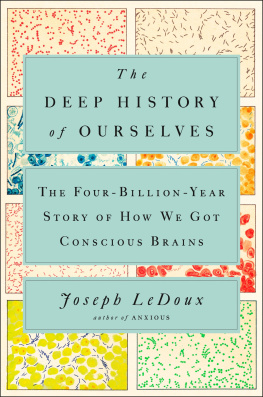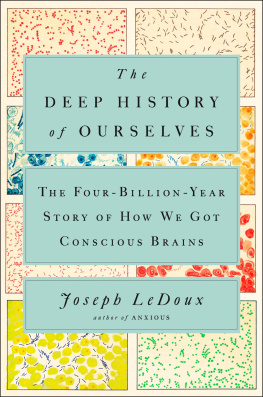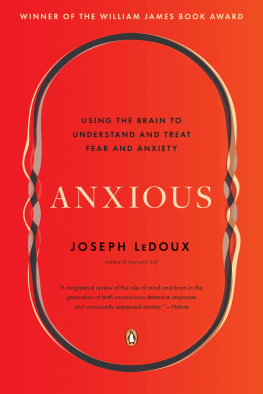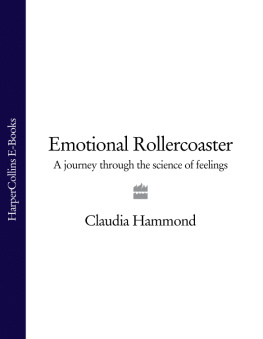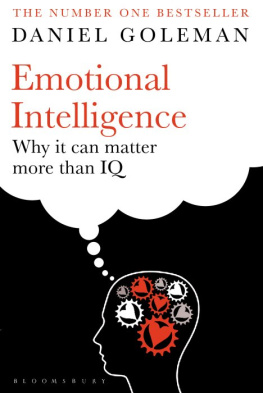Thank you for downloading this Simon & Schuster eBook.
Join our mailing list and get updates on new releases, deals, bonus content and other great books from Simon & Schuster.
C LICK H ERE T O S IGN U P
or visit us online to sign up at
eBookNews.SimonandSchuster.com
We hope you enjoyed reading this Simon & Schuster eBook.
Join our mailing list and get updates on new releases, deals, bonus content and other great books from Simon & Schuster.
C LICK H ERE T O S IGN U P
or visit us online to sign up at
eBookNews.SimonandSchuster.com

SIMON & SCHUSTER PAPERBACKS
Rockefeller Center
1230 Avenue of the Americas
New York, New York 10020
www.SimonandSchuster.com
Copyright 1996 by Joseph LeDoux
All rights reserved, including the right of reproduction in whole or in part in any form.
S IMON & S CHUSTER P APERBACKS and colophon are registered trademarks of Simon & Schuster Inc.
For information about special discounts for bulk purchases, please contact Simon & Schuster Special Sales: 1-800-456-6798 or .
Designed by Irving Perkins Associates
The Library of Congress has cataloged the hardcover edition as follows:
LeDoux, Joseph E.
The emotional brain: the mysterious underpinnings of emotional life / Joseph LeDoux
p. cm.
Includes bibliographical references and index.
1. EmotionsPhysiological aspects. 2. Neuropsychology.
QP401.L43 1996
152.4dc2096-24676
CIP
ISBN-13: 978-0-684-80382-1
ISBN-10: 0-684-80382-8
ISBN-13: 978-0-684-83659-1 (Pbk)
ISBN-10: 0-684-83659-9 (Pbk)
ISBN-13: 978-1-4391-2638-7 (eBook)
For the people who have had the greatest influence on my emotional brain:
Nancy, Jacob, and Milo
and
Pris and Boo
CONTENTS
P REFACE
I FIRST STARTED WORKING on the brain mechanisms of emotion in the late 1970s. At that time very few brain scientists were interested in emotions. In the intervening years, and especially recently, the topic has begun to be fairly heavily investigated, and a good deal of progress has been made. I thought it was time to share some of this information with the general public.
The Emotional Brain provides an overview of my ideas about how emotions come from the brain. It is not meant as an all-encompassing survey of every aspect of how the brain produces emotions. It focuses on those issues that have interested me most, namely, issues about how the brain detects and responds to emotionally arousing stimuli, how emotional learning occurs and emotional memories are formed, and how our conscious emotional feelings emerge from unconscious processes.
I tried to write The Emotional Brain so that it would be accessible to readers not trained in science or versed in scientific jargon. But I also tried not to water down the science. I hope Ive been successful in making the book readable and enjoyable for lay persons and scientists alike.
Im extremely grateful to my family for tolerating me while I struggled to write this book. I owe much to my wife, Nancy Princenthal, for her tireless reading of endless drafts of my book proposal, and then of the chapters, and for her many useful suggestions. Our two boys, Jacob and Milo, kept my emotional brain in tip-top shape throughout.
Many students and postdoctoral researchers have helped greatly in my past and current research on emotions in the brain: Akira Sakaguchi, Jiro Iwata, Piera Chichetti, Liz Romanski, Andy Xagoraris, Christine Clugnet, Mike Thompson, Russ Phillips, Maria Morgan, Peter Sparks, Kevin LaBar, Liz Phelps, Keith Corodimas, Kate Melia, Xingfang Li, Michael Rogan, Jorge Armony, Greg Quirk, Chris Repa, Neot Doron, Gene Go, Gabriel Hui, Mian Hou, Beth Stutzmann, and Walter Woodson. I have also had some important collaborators, including Don Reis, David Ruggiero, Shawn Morrison, Costantino Iadecola, and Terry Milner at Cornell Medical School; David Servan-Schreiber and Jon Cohen at the University of Pittsburgh; Asia Pitknen in Finland; and Chiye Aoki at NYU. And I will always be grateful to Claudia Farb for her many tangible and intangible contributions to my lab. Some of these people have had to do their work while I was writing the book. I apologize to them for being inaccessible, especially during those last days when it seemed that I might never finish. I also owe a great deal to Irina Kerzhnerman and Annette Olivero, who helped with many aspects of the final preparation of the book. Jorge Armony and Mian Hou assisted with the illustrations.
I also want to thank Mike Gazzaniga, my Ph.D. advisor, for showing me how to have fun while being a scientist, and for teaching me how to think about the mind. He encouraged me to write a book on emotions years before I actually got around to it. Im also grateful to Don Reis, who took me into his lab as a postdoc, taught me neurobiology, and provided me with the resources I needed to start pursuing the brain mechanisms of emotion.
The Neuroscience Research Branch at the National Institute of Mental Health has generously funded my work. The research that this book is based on could not have been done without this support. New York University, especially the Faculty of Arts and Science Deans Office, has also been very supportive. And I couldnt ask for better colleagues than those I have in the NYU Center for Neural Science.
Katinka Matson and John Brockman of Brockman, Inc., have been wonderful as literary agents. They were instrumental in helping me shape my proposal and in signing me up with Simon & Schuster, where Im pleased to have had the opportunity to work with Bob Asahina, who made only good editorial suggestions. I wish him luck in his new job, which took him away just as the book went into production. Bob Bender, who took over, has been wonderful as well, and Johanna Li.
Some people go on sabbatical to write books. Im now going on one to recover.
1
WHATS LOVE GOT TO DO WITH IT?

Our civilization is still in a middle stage, scarcely beast, in that it is no longer guided by instinct, scarcely human in that it is not yet wholly guided by reason.
Theodore Dreiser, Sister Carrie
M Y FATHER WAS A butcher. I spent much of my childhood surrounded by beef. At an early age, I learned what the inside of a cow looks like. And the part that interested me the most was the slimy, wiggly, wrinkled brain. Now, many years later, I spend my days, and some nights, trying to figure out how brains work. And what Ive wanted to know most about brains is how they make emotions.
You might think that this would be a crowded field of research. Emotions, after all, are the threads that hold mental life together. They define who we are in our own minds eye as well as in the eyes of others. What could be more important to understand about the brain than the way it makes us happy, sad, afraid, disgusted, or delighted?
For quite some time now, though, emotion has not been a very popular topic in brain science. Emotions, skeptics have said, are just too complex to track down in the brain. But some brain scientists, myself included, would rather learn a little about emotions than more about less interesting things. In this book, Ill tell you how far weve gotten. Skeptics be warned, weve gotten pretty far.
Of course, at some level, we know what emotions are and dont need scientists to tell us about them. Weve all felt love and hate and fear and anger and joy. But what is it that ties mental states like these together into the bundle that we commonly call emotions? What makes this bundle so different from other mental packages, ones that we are less inclined to use the term emotion for? How do our emotions influence every other aspect of our mental life, shaping our perceptions, memories, thoughts, and dreams? Why do our emotions often seem impossible to understand? Do we have control over our emotions or do they control us? Are emotions cast in neural stone by our genes or taught to the brain by the environment? Do animals (other than human ones) have emotions, and if so do all species of animals have them? Can we have unconscious emotional reactions and unconscious emotional memories? Can the emotional slate ever be wiped clean, or are emotional memories permanent?
Next page

